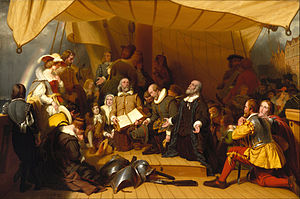
Back Pilqremlər Azerbaijani Puichavodan BAR Бацькі-пілігрымы Byelorussian Пилигрими Bulgarian Pares pelegrins Catalan Otcové poutníci Czech Pilgrimmene Danish Pilgerväter German Padres peregrinos Spanish زائران (مستعمره پلیموت) Persian

The Pilgrims, also known as the Pilgrim Fathers, were the English settlers who travelled to North America on the ship Mayflower and established the Plymouth Colony at what now is Plymouth, Massachusetts. John Smith had named this territory New Plymouth in 1620, sharing the name of the Pilgrims' final departure port of Plymouth, Devon. The Pilgrims' leadership came from religious congregations of Brownists or Separatists who had fled religious persecution in England for the tolerance of 17th-century Holland in the Netherlands.
These Separatists held many of the same Calvinist religious beliefs as Puritans, but unlike Puritans (who wanted a purified established church), Pilgrims believed that their congregations should separate from the state church, which led to their being labelled Separatists. After several years of living in exile in Holland, they determined to establish a new settlement in the New World and arranged with investors to fund them. In 1620, they established the Plymouth Colony, in which they erected Congregational churches.[1] The Puritans' later establishment of the Massachusetts Bay colony eventually became more powerful in the area; but the Pilgrims' story nevertheless became a central theme in the history and culture of the United States.[2]
- ^ Johnson, Daniel L. (1990). Theology and Identity – Traditions, Movements, and Polity in the United Church of Christ. Cleveland, Ohio: United Church Press. pp. 4. ISBN 0-8298-0807-8.
- ^ Davis, Kenneth. C. "America's True History of Religious Tolerance". Smithsonian. Retrieved September 21, 2016.